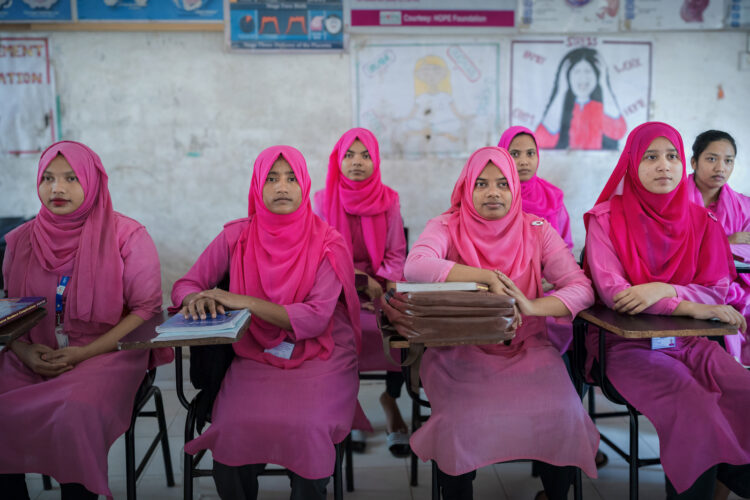New: Global Standards for Midwife Faculty Development

The International Confederation of Midwives (ICM) has released the Global Standards for Midwife Faculty Development and the Companion Guidelines. These are the first global standards developed specifically for midwife faculty and mark a significant step to ensure midwifery educators and midwifery education are grounded in quality, innovation, opportunity and evidence-based practice.
ICM defines Faculty as a group of qualified individuals who teach midwife students in a midwifery programme (e.g., midwife educators, experts from other disciplines, clinical preceptors/teachers). The more specific term Midwife Faculty refers to those educators who are qualified midwives and primarily responsible for teaching midwife students (e.g., midwife heads/directors; midwife teachers; and midwife clinical preceptors/teachers).
The global standards were developed by a working group of international midwife educators and researchers, led by a consultant and refined through extensive rounds of consultation, building on midwife faculty and midwifery education research and policy. A global consultation on the final draft gathered feedback from respondents across all ICM regions and from UN agencies. The standards were approved via the ICM Council in June.
These new standards set out clear expectations for midwife faculty development, enabling institutions and countries to build a highly skilled and adaptive workforce of midwife educators. They build on other ICM education resources and strengthen support for institutions or programmes to meet the Global Standards for Midwifery Education and Global Standards for Midwifery Regulation, and to ensure the Essential Competencies for Midwifery Practice are embedded in midwifery curricula. These global standards will support midwife faculty development, who will, in turn, prepare future generations of competent midwives.
Background
Globally, it is well recognised that midwife educators and faculty need ongoing professional development for their role. The World Health Organization’s (WHO) Strengthening Quality Midwifery Education for Universal Health Coverage 2030 and the Global Strategic Directions for Nursing and Midwifery 2021–2025 both prioritise strengthening midwife faculty development to ensure the delivery of high-quality midwifery education programmes. In addition, the Midwifery Accelerator calls for urgent, significant investment in education, including developing or building the capacity of midwife faculty to design, deliver and evaluate programmes of study. These sustained calls for a focus on midwife faculty provide the impetus and rationale for the development of the Global Standards for Midwife Faculty Development.
Challenges in the preparation and continued development of midwife faculty have been identified across all midwifery education settings, including:
- Lack of supportive pathways from clinical to academic practice, including the ability for educators to remain connected to practice and maintain midwifery competencies.
- Lack of investment in education and in educators.
- Lack of recognised career pathways or opportunities to develop outside classroom teaching (e.g., research capacity).
- Lack of provision of, and/or access to, faculty development programmes, including new teaching pedagogies and adaptation to technological advances.
The need for global standards
Strengthening the capacity of midwife faculty is critical to improving the quality of care. High-quality pre-service midwifery education programmes depend on midwife faculty who have been appropriately prepared for, and supported in, educational practice; who maintain a practice connection; and who remain competent in the essential competencies for midwifery practice. All midwife faculty development programmes should start with a faculty needs assessment. By listening to the experiences of midwife faculty, students and communities, programmes can be tailored to local contexts and challenges, ensuring education is both high-quality and relevant.
Research suggests that where faculty development is available, there is often insufficient consideration of context-specific, individual and institutional needs. Programmes for midwife faculty development are frequently based on international partnerships between high- and low-resource settings and are not always adequately evaluated for impact on student experience or adaptations to curriculum design and teaching methodologies. A recent systematic review in low- and middle-income countries found wide variation in programmes, with inconsistency in content and gaps in recommended core components such as student assessment and integration of digital technologies. The study recommended an urgent need for global standards to guide future programmes.
Looking ahead: from policy to practice
The launch of the Global Standards for Midwife Faculty Development comes at a critical time. Teaching methodologies and educational approaches are rapidly evolving to meet the needs of new students. The much-needed integration of competency-based education into midwifery education programmes often requires midwife faculty to rethink and reimagine delivery. This is further shaped by digital solutions, virtual learning and innovative curriculum design and placement provision to prepare students to provide competent care within midwifery models of care.
Globally, there continue to be shortages of qualified midwives, particularly in low- and middle-income countries. In high-income countries, funding for midwife faculty development is often restricted or reduced. Expanding faculty development and enabling skilled educators is essential to addressing these educational gaps.
The Global Standards for Midwife Faculty Development are designed to be used widely by:
- Educational institutions
- Midwives’ associations
- Regulators
- Ministries of health and education
- Non-governmental organisations
They provide benchmarks for programme design, accreditation and evaluation, while also offering midwife faculty a framework for continuous professional development. The standards ensure leadership, collaboration and evidence-based practice are embedded into faculty development, and position midwife educators as key drivers of change — as teachers, researchers, advocates and practitioners who remain closely connected to midwifery practice and hands-on care.
Call to action
ICM emphasises that the Global Standards for Midwife Faculty Development are a minimum requirement for midwife educators’ development. To fully realise their potential, investment and support will be needed from governments, institutions and development partners. Ensuring equitable access to faculty development, regardless of geography or resources, is fundamental to their success.
The world needs One Million More Midwives
Sign the petition and help us collect one million signatures to demand one million more midwives — and the investments needed to make it happen.
